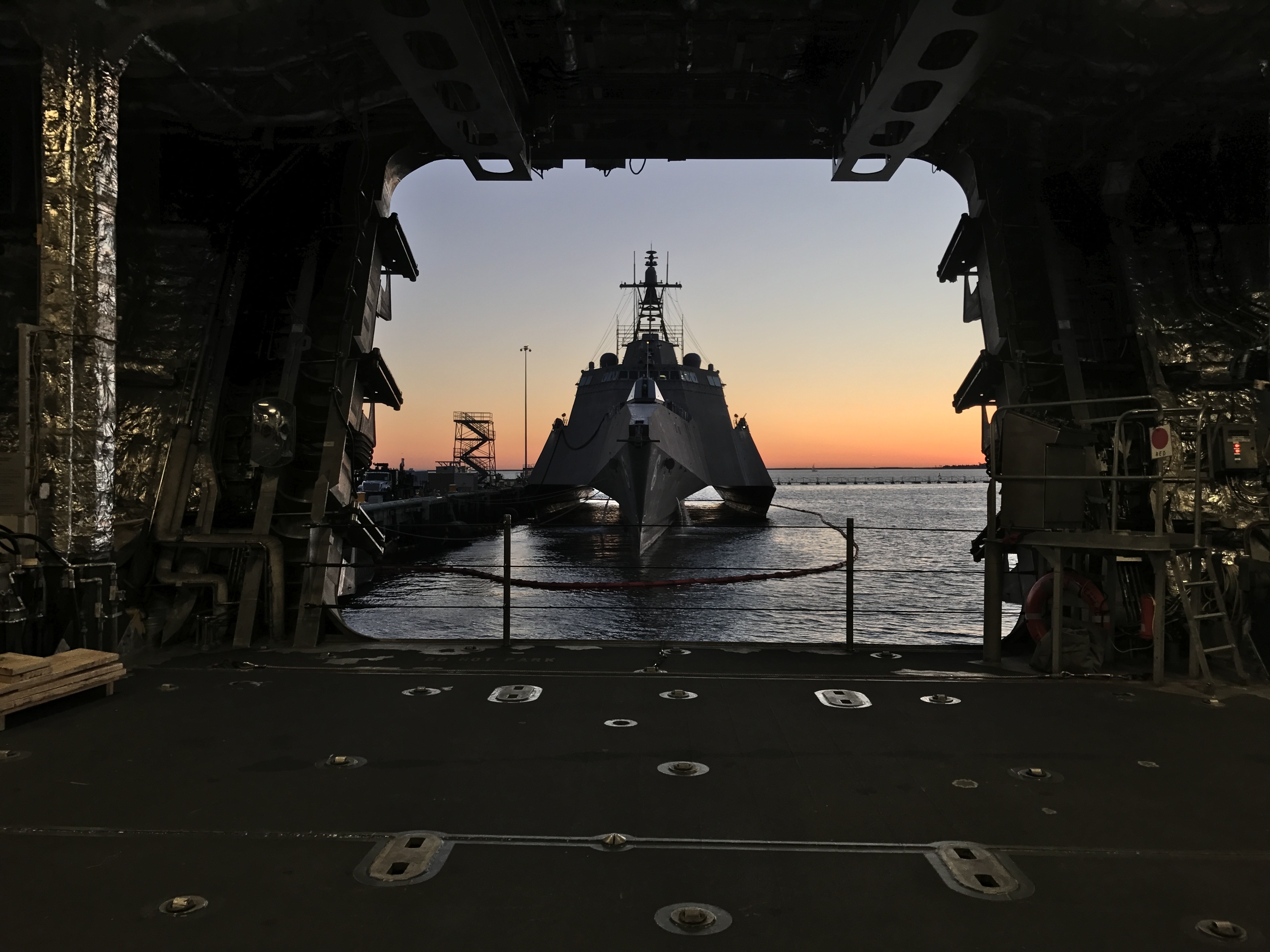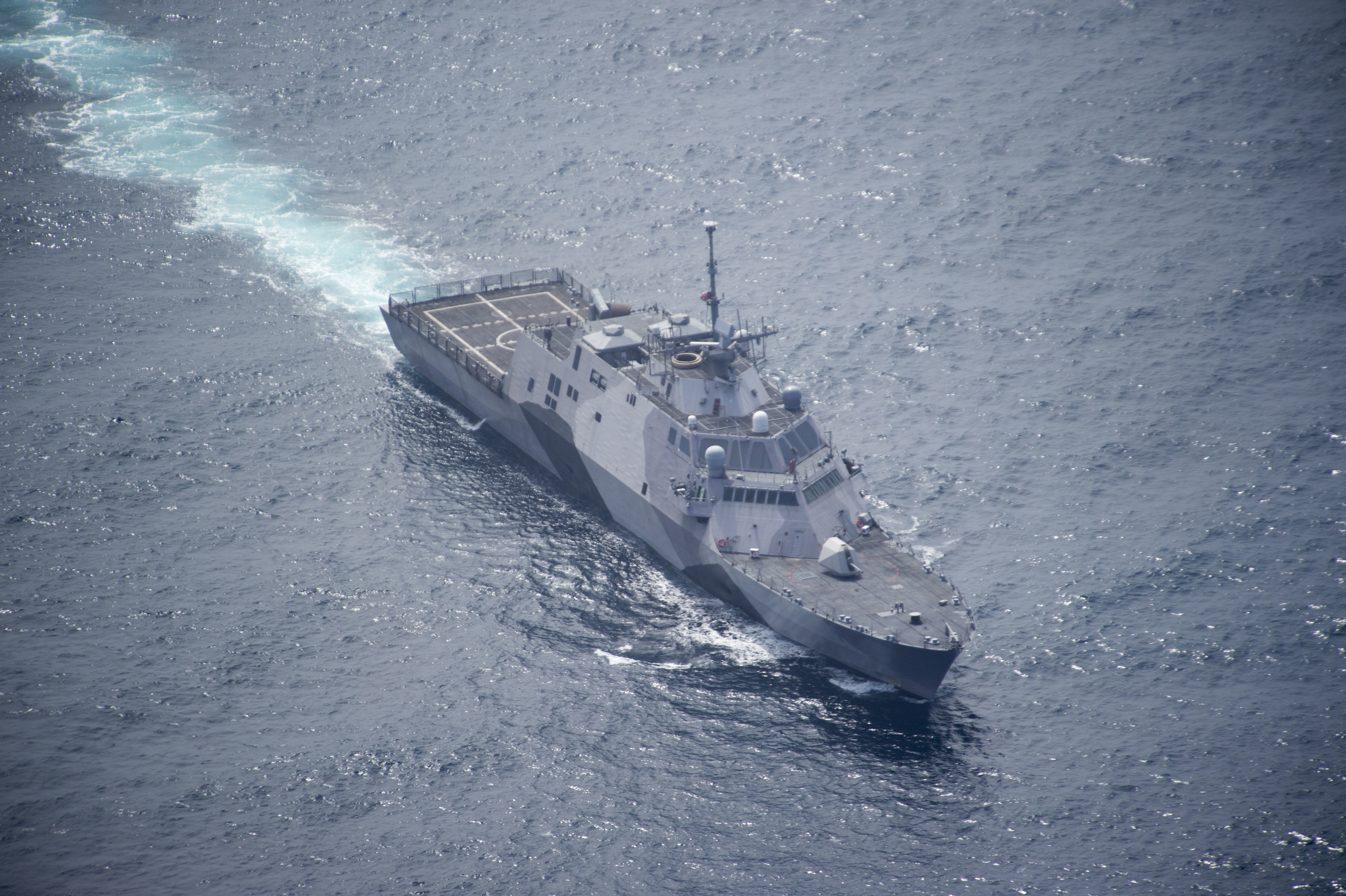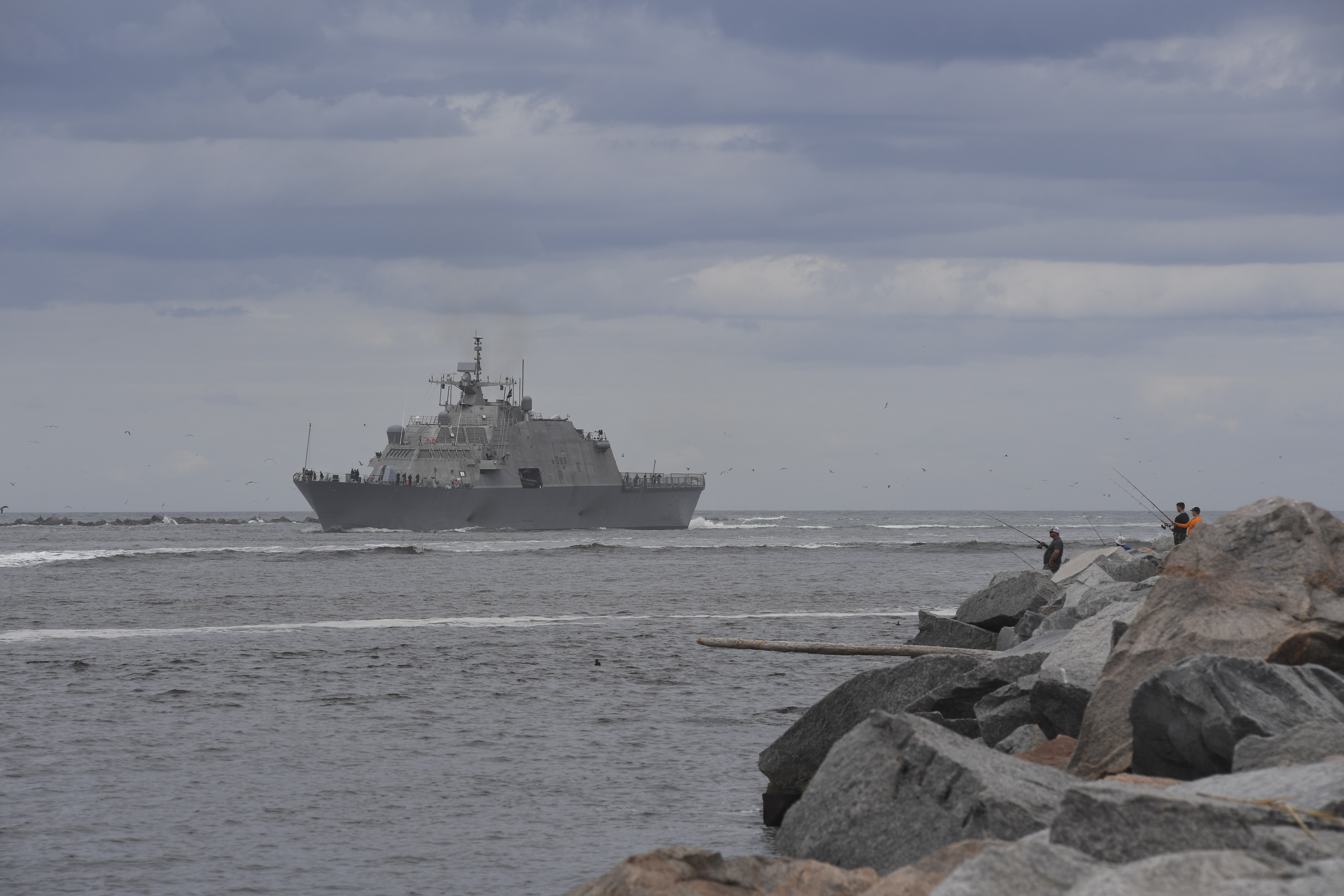
This article is the second in a three-part series on the changes occurring in the Littoral Combat Ship community as the fleet rapidly grows, moves to a new crewing and organizational construct and prepares for multi-ship forward operations.
SAN DIEGO — A flurry of Littoral Combat Ship activity on the San Diego waterfront belies any thought the program is in a sleepy infancy phase.
There is more LCS activity taking place now than in the history of the program. Both Austal USA and Lockheed Martin continue to churn out new ships. All three mission packages – surface warfare, mine countermeasures and anti-submarine warfare – are in development. Several ships are in maintenance, and new crews are forming and training ahead of at least three upcoming deployments. One ship, USS Coronado (LCS-4) is operating out of Singapore today. And the crews and LCS squadrons are reorganizing themselves to maximize operational readiness.
Cmdr. Michel Falzone and Cmdr. Emily Cathey, commanding officers of USS Freedom (LCS-1) and USS Independence (LCS-2), respectively, recently showed USNI News around their ships, docked next to each other at Naval Base San Diego. The two commanders are keeping busy implementing recent changes to the LCS organization and embarking on their new mission to test out mission module gear that will eventually be evaluated by the Navy and deployed on other LCSs.
The test division in LCS Squadron 1 (LCSRON-1) – which includes Freedom, Independence, USS Fort Worth (LCS-3) and Coronado – is informally stood up, pending final paperwork. In testing mission module equipment, Freedom will focus on anti-submarine warfare, Independence and Fort Worth will focus on mine countermeasures, and Coronado will take on surface warfare.

PACIFIC OCEAN (April 09, 2017) An MQ-8C Fire Scout helicopter sits on the deck of Independence-class littoral combat ship USS Montgomery (LCS 8). Sailors and the Fire Scout testing team are underway conducting dynamic interface testing to verify the MQ-8C launch and recovery procedures and test interoperability between the unmanned helicopter and the ship. The MQ-8C Fire Scout is a larger variant than the MQ-8B and provides longer endurance, range and greater payload capability. (U.S. Navy photo by Command Master Chief Jacob A. Shafer/Released)
Falzone and Cathey and their crews aren’t wasting any time embracing their test ship responsibilities. Freedom and Independence have not yet been sent to sea for mission module testing, but both skippers are conducting in-port testing of systems that will eventually detect and destroy mines and hunt submarines.
Cathey and the Independence crew recently finished in-port testing with the Mk 18 Mod 2 Kingfish unmanned underwater vehicle, which was the ship’s main focus for a time. The Kingfish has previously deployed from rigid-hull inflatable boats with an expeditionary mine countermeasures company (ExMCM), and Independence had been conducting checks of the RHIBs on the LCS-2 variant of the ship, after a similar demonstration on Freedom last summer.
More broadly, Cathey said her crew had been working with Explosive Ordnance Disposal Group 1, who developed the ExMCM capability, to look at how compatible their gear is and what modifications, if any, would have to be made to the ship, the EOD Group’s RHIBs, dive chambers and more to allow the LCS to successfully launch EOD divers into the water, as an alternative to the unmanned vehicles and sensors included in the LCS mine countermeasures mission package.
Now the ship is turning to Coastal Battlefield Reconnaissance and Analysis (COBRA) integration on the ship, working through the communications and the testing procedures for that piece of the mission package.
“As we evolve the mission package hardware here … all of the plans are to go to the unmanned surface vehicles, with Kingfish, COBRA off of the (MQ-8B/C) Firescout, and then to take the development spirally along that type of hardware – and then the maintenance as aspect of maintaining that hardware – this is going to be your test bed, your platform here,” LCSRON-1 commodore Capt. Jordy Harrison told USNI News while aboard Independence, adding that the test ship crews will also work through doctrine; tactics, techniques and procedures; and learning how to best develop expertise in less-common warfare areas like mine countermeasures.

The work being done on the components of the LCS mine countermeasures mission package will ultimately inform when and how the Navy conducts its formal test and evaluation ahead of declaring initial operational capability.
“I’ve got an experienced crew that provides some of the background and the experience operating the LCS and frankly experience with the MCM to help inform this decision-making process,” Cathey said.
On Freedom, Falzone said the anti-submarine warfare package is the least far along in development – it will be the last to be fielded, and therefore the ASW division within the LCSRON will be the last to stand up – but good work is already taking place on the ship. She said helicopters with sonobuoys will deploy as part of the mission package, so ahead of eventual at-sea testing “we’ve been testing the datalinks between the two to ensure [the ship is] capable of taking that information and using that as an additional asset for ASW.”
Outside of the ASW package, Freedom also conducted its first Coast Guard helicopter landing on the flight deck earlier this year and hopes to do more interoperability testing with the Coast Guard going forward.
Capt. Jon Rucker, the unmanned systems program manager at the Program Executive Office for Littoral Combat Ships, said the decision to create a dedicated test division would certainly benefit the development and acquisition timeline.
“It’s actually very promising for us to have dedicated test assets,” he said, noting the PEO still has to work around the crew’s training schedule but does not have to compete with other fleet requirements to get time at sea for testing.
“In the end it’s a benefit to the warfighter because we can ensure we get things tested, meet the requirements of the acquisition to get them the capability quicker.”
Rucker added that the stand-up of the test division comes as more systems in the mission packages are reaching the point of requiring at-sea and on-ship testing and demonstrations.
Beyond testing mission module hardware, Cathey and Falzone have been paving the way forward for the LCS community in terms of integrating the former mission package detachments with the ship’s core crew. Both skippers have fully integrated the two teams, bringing the ship’s crew from about 50 to 70.
“That has helped tremendously” in terms of sharing in watchstanding duties, ship maintenance work and more, Cathey said. The minemen and enginemen in the old detachment are being incorporated into the engineering, weapons and other departments based on their individual backgrounds and expertise, to best leverage each individual’s talents.
Falzone said her ship’s crew is still small enough that ratings don’t matter as much as they do in other communities.
“I have IT-men who are trained to be boat operators. We have a sonar tech who we’re going to send to coxswain school because she wants to drive a boat. So there’s just so many different things. We have a fire controlman who wants to be a qualified officer of the deck, so we are definitely blurring the lines there and not limiting people by their rating. It’s really the only way we can get through it,” she said, adding that a sonar tech and an operational specialist are also learning to stand engineering watches. Previous LCS crews have told USNI News a similar story, with sometimes five or six crew members qualifying as search and rescue swimmers because so many sailors are dual- and triple-hatted.
Fort Worth is expected to move to the same single-crew model this month, and Coronado will do the same when it returns home from its current deployment to Singapore. Coronado has been testing out an over-the-horizon missile capability during its deployment, though, so in a way is already embracing its test ship status even ahead of its formal transition into the test division.

In LCSRON-1’s next division – Division 11, which will stand up in October and focus on surface warfare – USS Jackson (LCS-6), USS Montgomery (LCS-8) and USS Gabrielle Giffords (LCS-10) are in or will soon be in maintenance, and the future Omaha is set for commissioning later this year. Jackson will serve as the training ship, and the other three will deploy for about 18 months at a time with a rotational blue/gold crew construct. Cathey said the Independence crew is supporting these crews as they work through certification events, and Harrison said LCSRON-1 is supporting the LCSRON-2 in Florida until the East Coast LCS infrastructure catches up to the West Coast.
Harrison noted that as the LCS community continues to implement its new crewing and organizational model, all eyes are on next year’s expected three LCS deployments aboard and ensuring that the ships and crews slated to deploy are ready to go on time.
“The intent and the plan is, in the summer of next year to deploy the first ship, Montgomery, the first ship on the East Coast in their division, which will be Detroit – Milwaukee being the training ship – deploy those ships in the summer next year, and then what you will see is about every six months thereafter the second ship, the third ship to deploy, because that’s kind of the timing … to deliver two ships from each of the build yards each year,” Harrison explained.
“We’re a little farther along with the [Independence]-variant than we are with the [Freedom]-variant due to some of the engineering redesign they had to do with their plant for the combining gears. So I think we will probably have a little more early a little more set schedule, and it might take a little bit of time on the East Coast, but they’ll quickly catch up and get into the same kind of drum beat from the deployment perspective.”
Capt. Tom Workman, the LCS Implementation Team leader who oversees the move to the new organizational and operational ideas that came out of last year’s LCS Review, stressed that all the activities taking place on the waterfront now are important to getting next year’s deployments off to a successful start – and in turn, those deployments would shape how the program moves forward.
“Getting the ships out there to serve their operational commanders, that’s the first and foremost initiatives, and then how they get used in the different AOR [areas of responsibility], we take that feedback back into the program,” he told USNI News from his office at Naval Amphibious Base Coronado.
“Go operate forward and bring those lessons back and integrate that into the training process. That’s exciting.”

SAN DIEGO (July 5, 2017) The littoral combat ship USS Gabrielle Giffords (LCS 10) transits San Diego Bay to arrive at the ship’s homeport of Naval Base San Diego. Gabrielle Giffords is the newest Independence-variant littoral combat ship and one of seven littoral combat ships homeported in San Diego. (U.S. Navy photo by Mass Communication Specialist Seaman Nicholas Burgains/Released)
Workman said much of the focus on LCS so far has been getting the ship design right, defining and developing the mission packages and trying to get at-sea testing done. Now, he said, more attention can finally turn to operating the ships as intended and learning even more from that process.
“I know how one LCS can do this mission in this AOR. Two doesn’t just mean more flexibility in terms of numbers, it means more capability and capacity as well. I can now operate two together, or I can operate two independently, et cetera. From a [surface warfare] standpoint, how do I best position these two LCS assets for this mission? We’ll get tactical experience into the individual and or mutual employment of LCSs, and that’s exciting,” he said.
“As those first deployments happen and you start to flex capabilities on both sides of the world, and you start to develop capacity and capability, the interest level will only go up. Those ships will speak for themselves once they are able to start operating in greater numbers, and from an implementation team standpoint, it’s motivating to be doing the programmatic things, the setup things that we can to get them out there operating in numbers. At this point they’re speaking for themselves – Coronado is performing and staking its reputation. Programmatically we’re setting up the others so they can go and operate and speak for themselves, let their operational success carry the LCS message. It’s motivating, from an implementation team standpoint, to be doing some of the mechanics that will facilitate that.”





